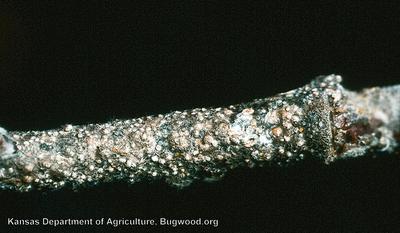San-Jose-Scale
Comstockaspis perniciosa
Insect
In a Nutshell
- Slight dent and red to purple spot around feeding sites.
- Formation of small, deformed and dull-coloured fruit.
Can also be found in
Symptoms
The scale insect sucks sap from branches, leaves, and fruits. This feeding habit leads to slight depression with red to purple halos on the fruit surface. Although an individual scale cannot inflict much damage, a single female and her offspring can produce several thousand scales in one season. These insects particularly live in large older trees where it is difficult to achieve good spray coverage, but young, sprayed trees may also be vulnerable. Although they primarily live in tree barks, surviving under scales and in crevices, the first indication in the orchard may be small red spots on fruits and leaves. Fruit damage is usually concentrated at the bottom of the fruit. If an infestation occurs early in the season, the fruit may become small or deformed. This leads to an overall decline in plant vigour, growth, and yield.
Recommendations

Organic Control
Introduce natural enemies that feed on the San Jose Scales such as the twice-stabbed lady beetle or Cybocephalus californicus. Additionally, a few small chalcids and aphelinid wasps parasitise the scale. Spray 2% horticultural oil just before or right after bud break, but before the flowers begin to bud. Aphytis Spp., Encarsia Perniciosi and Coccinella Infernalis Mulsant as predators are recognized as benefiting biological control agents. Release parasitoids such as Encarsia Pernicious 2000 to infested trees once during spring in endemic areas.

Chemical Control
Always consider an integrated approach with preventive measures together with biological treatments, if available. Control heavy populations by applying an insecticide plus oil spray during the delayed dormant period. Apply Insecticides containing insect growth regulators such as pyriproxyfen or buprofezin, neonicotinoids, organophosphates or spirotetramat when you find the first adults in pheromone traps or the first crawlers on sticky tapes. Follow with subsequent sprays 10 days later if you continue to find active crawlers.
What caused it?
Damage is caused by the fruit tree pest of the San Jose scale. The females are yellow, wingless and are soft, globular in shape. They are about 1.5-2.2mm long with a dark band across the back. The nymph goes through three stages of crawler, white cap, and black cap. It can complete its life cycle in approximately 37 days, with two generations of the insect each year. Development of the insect resumes in spring when temperatures exceed 51°F. Overwintering nymphs become active in mid-march and the males emerge in April. Females are ovo-viviparous and reproduce in mid-may producing between 200 and 400 nymphs in a month. A typical life cycle is completed in 35-40 days, and the insects begin to grow during the blooming period. The female scale is round, slightly convex with a black pustule while the male is linear.
Preventive Measures
- Orchard sanitation should be given top priority.
- A simple removal of alternative hosts, weeds, volunteer plants, and crop residues can greatly reduce the infesting potential.
- Heavily infested branches should be pruned, burned and destroyed.
- Examine trees carefully during dormancy to determine the level of infestation.
- Look out for trees that retain leaves during winter as this is a good indication of the presence of the insect.
- Use pheromone traps to detect the presence of males.
- Place traps on the northern and eastern side of trees at a height of six to seven feet, and check weekly.
- Infested branches should be pruned out to reduce the population and improve spray penetration.
- Spray a delayed dormant oil when buds are showing green issues but before turning pink.
- Insecticide applications can control newly emerged crawlers in early summer.



